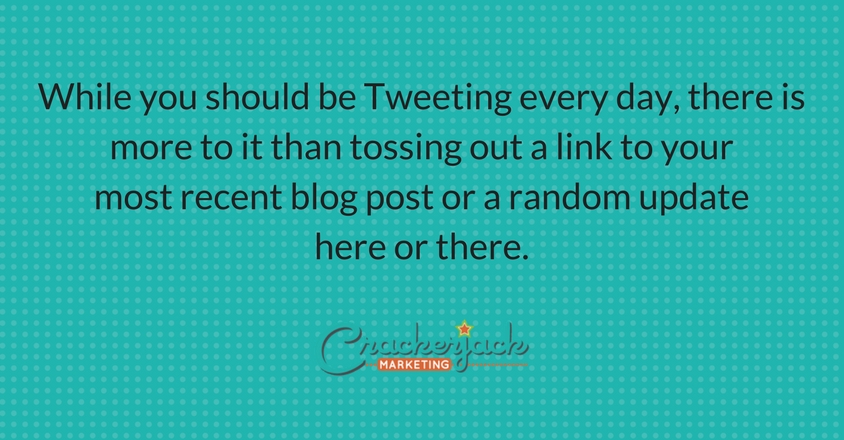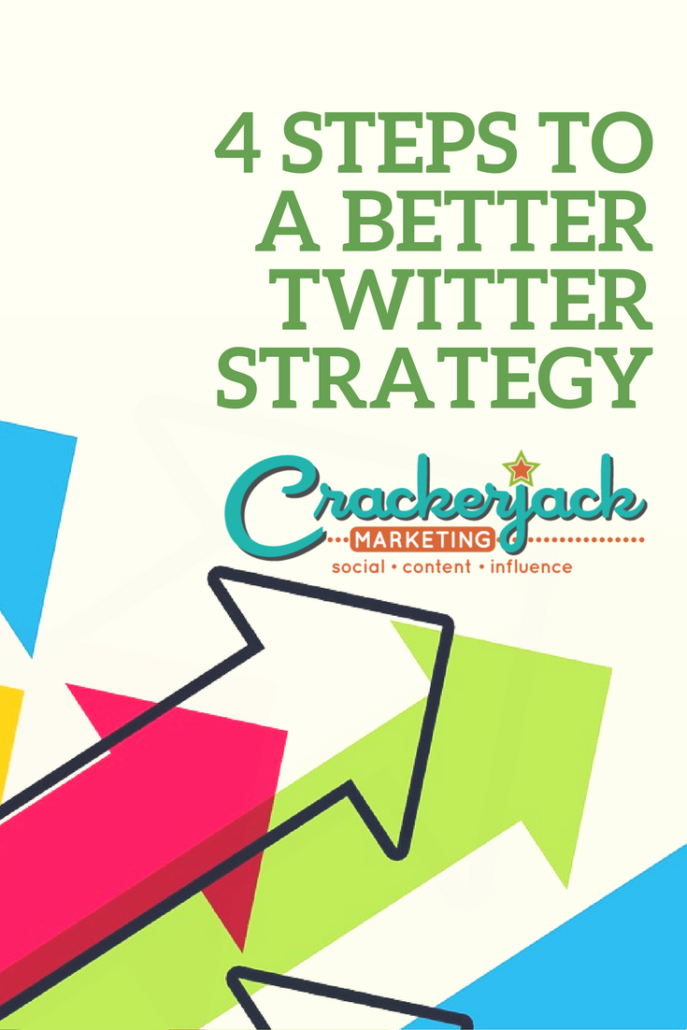Twitter Strategy
“4 Steps to a Better Twitter Strategy” is co-authored by Stephanie Schwab and Christina Strickland.

With over 106 million users sending more than a total of 140 million updates per day; you can see why we think Twitter is an essential platform for your business. We’ve written about Twitter a lot, everything from finding people to follow, finding content to share and explaining why Twitter Moments matters to your brand.
Now that you’ve gotten the basics down, it’s time to fine tune your Twitter strategy so you can maximize the benefits.
4 Steps to a Better Twitter Strategy
One of the questions businesses often ask is “How often should I Tweet?” This topic has been debated by social media pundits, almost since the dawn of Twitter. The truth is, there isn’t a “one size fits all” answer. The number of Tweets you should send is directly tied to the size of your Twitter community and your content.
One of the questions businesses often ask is “How often should I Tweet?” This topic has been debated by social media pundits, almost since the dawn of Twitter. The truth is, there isn’t a “one size fits all” answer. The number of Tweets you should send is directly tied to the size of your Twitter community and your content.
While you should be Tweeting every day, there is more to it than tossing out a link to your most recent blog post or a random update here or there. Here are four things you should be doing if you plan on keeping up on Twitter:

1. Tweet consistently
For your brand or business, this may mean seven days a week or only Monday – Friday, depending on when your customers are online. This doesn’t mean scheduling or tweeting at the same time, every day. It means that you shouldn’t send out 65 tweets in one day and then not return to Twitter for a month.
2. Keep your Twitter content balanced
Think of Twitter as a party or networking meeting you don’t want to be one of the people everyone avoids because all they do is talk about themselves.
The same principle applies to Twitter. If your tweets are constantly about your own business or blog posts, your followers will catch on and ignore them. Even worse, they are likely to quickly unfollow you. Instead, keep your Twitter stream filled with a lively mix of brand updates and curated content.
3. Schedule your Twitter content
There’s no need to make Twitter any harder that it needs to be (though, really, it’s not that hard, once you get the hang of it). Because you’ve got a lot of moving pieces, it’s a good idea to not only use an editorial calendar (you can get our free editorial calendar here) but also use to tools to help you schedule what content you can in advance.
If you’re using Hootsuite, there is a built-in scheduling feature you can use. If you’re not using a 3rd party Twitter dashboard, take a look at Buffer, a simple tool that takes the guesswork out of Twitter timing and also allows you to schedule tweets in advance, so that you can get out from behind your desk. With Buffer, your content will get the best possible engagement in terms of link-clicks and retweets. Buffer is extremely easy to use, so we recommend it for people who are eager to ramp up their Twitter efforts and start to publish a lot of content but not ready for a full-fledged dashboard, like Hootsuite.
4. Stay engaged
We can’t put enough emphasis on this! Twitter is more than just a collection of links and announcements. It’s about having conversations. Remember, people respond to people. When responding to other Twitter users, retweeting other people’s content or joining in on a conversation, you really can’t tweet too often.
Use the above tips to get your tweeting on track. And keep in mind that it’s okay to experiment a little, update at different times and at different frequencies, and tweet out different types of content to find out what resonates with your Twitter followers. The most important thing is that you just do it and do it consistently, with good content and your community in mind.

She’s been in social media for over 20 years, and teaches digital marketing at universities in Barcelona and Bangkok.
Follow her on LinkedIn
for expert LinkedIn and marketing advice.
STEPHANIE SCHWAB
CEO & Founder
Stephanie is the Founder and CEO of Crackerjack Marketing.
She’s been in social media for over 20 years, and teaches digital marketing at universities in Barcelona and Bangkok.
Follow her on LinkedIn
for expert LinkedIn and marketing advice.
Categories
Twitter Strategy
“4 Steps to a Better Twitter Strategy” is co-authored by Stephanie Schwab and Christina Strickland.

With over 106 million users sending more than a total of 140 million updates per day; you can see why we think Twitter is an essential platform for your business. We’ve written about Twitter a lot, everything from finding people to follow, finding content to share and explaining why Twitter Moments matters to your brand.
Now that you’ve gotten the basics down, it’s time to fine tune your Twitter strategy so you can maximize the benefits.
4 Steps to a Better Twitter Strategy
One of the questions businesses often ask is “How often should I Tweet?” This topic has been debated by social media pundits, almost since the dawn of Twitter. The truth is, there isn’t a “one size fits all” answer. The number of Tweets you should send is directly tied to the size of your Twitter community and your content.
One of the questions businesses often ask is “How often should I Tweet?” This topic has been debated by social media pundits, almost since the dawn of Twitter. The truth is, there isn’t a “one size fits all” answer. The number of Tweets you should send is directly tied to the size of your Twitter community and your content.
While you should be Tweeting every day, there is more to it than tossing out a link to your most recent blog post or a random update here or there. Here are four things you should be doing if you plan on keeping up on Twitter:

1. Tweet consistently
For your brand or business, this may mean seven days a week or only Monday – Friday, depending on when your customers are online. This doesn’t mean scheduling or tweeting at the same time, every day. It means that you shouldn’t send out 65 tweets in one day and then not return to Twitter for a month.
2. Keep your Twitter content balanced
Think of Twitter as a party or networking meeting you don’t want to be one of the people everyone avoids because all they do is talk about themselves.
The same principle applies to Twitter. If your tweets are constantly about your own business or blog posts, your followers will catch on and ignore them. Even worse, they are likely to quickly unfollow you. Instead, keep your Twitter stream filled with a lively mix of brand updates and curated content.
3. Schedule your Twitter content
There’s no need to make Twitter any harder that it needs to be (though, really, it’s not that hard, once you get the hang of it). Because you’ve got a lot of moving pieces, it’s a good idea to not only use an editorial calendar (you can get our free editorial calendar here) but also use to tools to help you schedule what content you can in advance.
If you’re using Hootsuite, there is a built-in scheduling feature you can use. If you’re not using a 3rd party Twitter dashboard, take a look at Buffer, a simple tool that takes the guesswork out of Twitter timing and also allows you to schedule tweets in advance, so that you can get out from behind your desk. With Buffer, your content will get the best possible engagement in terms of link-clicks and retweets. Buffer is extremely easy to use, so we recommend it for people who are eager to ramp up their Twitter efforts and start to publish a lot of content but not ready for a full-fledged dashboard, like Hootsuite.
4. Stay engaged
We can’t put enough emphasis on this! Twitter is more than just a collection of links and announcements. It’s about having conversations. Remember, people respond to people. When responding to other Twitter users, retweeting other people’s content or joining in on a conversation, you really can’t tweet too often.
Use the above tips to get your tweeting on track. And keep in mind that it’s okay to experiment a little, update at different times and at different frequencies, and tweet out different types of content to find out what resonates with your Twitter followers. The most important thing is that you just do it and do it consistently, with good content and your community in mind.

Search our Blog
Get our Free Editorial Calendar Template.
Are you stressed out by the time it takes to create great content?
In this handy Google Doc, which you can save and use on your own, you’ll get a super-simple layout to guide your content creation and management efforts.
DOWNLOAD TODAY
STEPHANIE SCHWAB
CEO & Founder
Stephanie founder and CEO of Crackerjack Marketing.
She’s been in social media for over 20 years, and teaches digital marketing at universities in Barcelona and Bangkok.
Follow her on LinkedIn
for expert LinkedIn and marketing advice.
Create your own spark
Join 5,000+ marketers who receive our B2B marketing ideas and insights each week.
Join 5,000+ marketers who receive our B2B marketing ideas and insights each week.
Who We Serve
Company
Who We Are
Our Services
Blog
Free Editorial Calendar Template
Work With Us
Resources
Chicago, Barcelona, Mumbai
1055 W. Bryn Mawr Suite F-196
Chicago, IL 60660
+1-312-429-5588
Headquarters:
© Copyright 2025 Kyle Partners, LLC, d/b/a Crackerjack Marketing. All rights reserved. | Terms of Service | Privacy Policy